Critical Appraisal of Articles on Hypertension Management Practices
VerifiedAdded on 2022/08/29
|15
|4567
|30
Report
AI Summary
This report critically appraises two articles related to evidence-based practices in hypertension management. The first article explores the adoption of team-based hypertension care by nursing professionals, emphasizing its potential to improve patient outcomes and reduce healthcare costs. The report evaluates the credibility and applicability of this approach, highlighting the authors' qualifications and the article's strengths and weaknesses. The second article focuses on ambulatory blood pressure monitoring (ABPM) as a valuable tool for diagnosing and managing hypertension. The report appraises the authors' expertise and the article's aim to promote the use of ABPM in clinical practice. The analysis includes an assessment of the articles' methodologies, supporting evidence, and the practical implications for nursing professionals, considering both the benefits and potential challenges of implementing these practices in real-world healthcare settings.
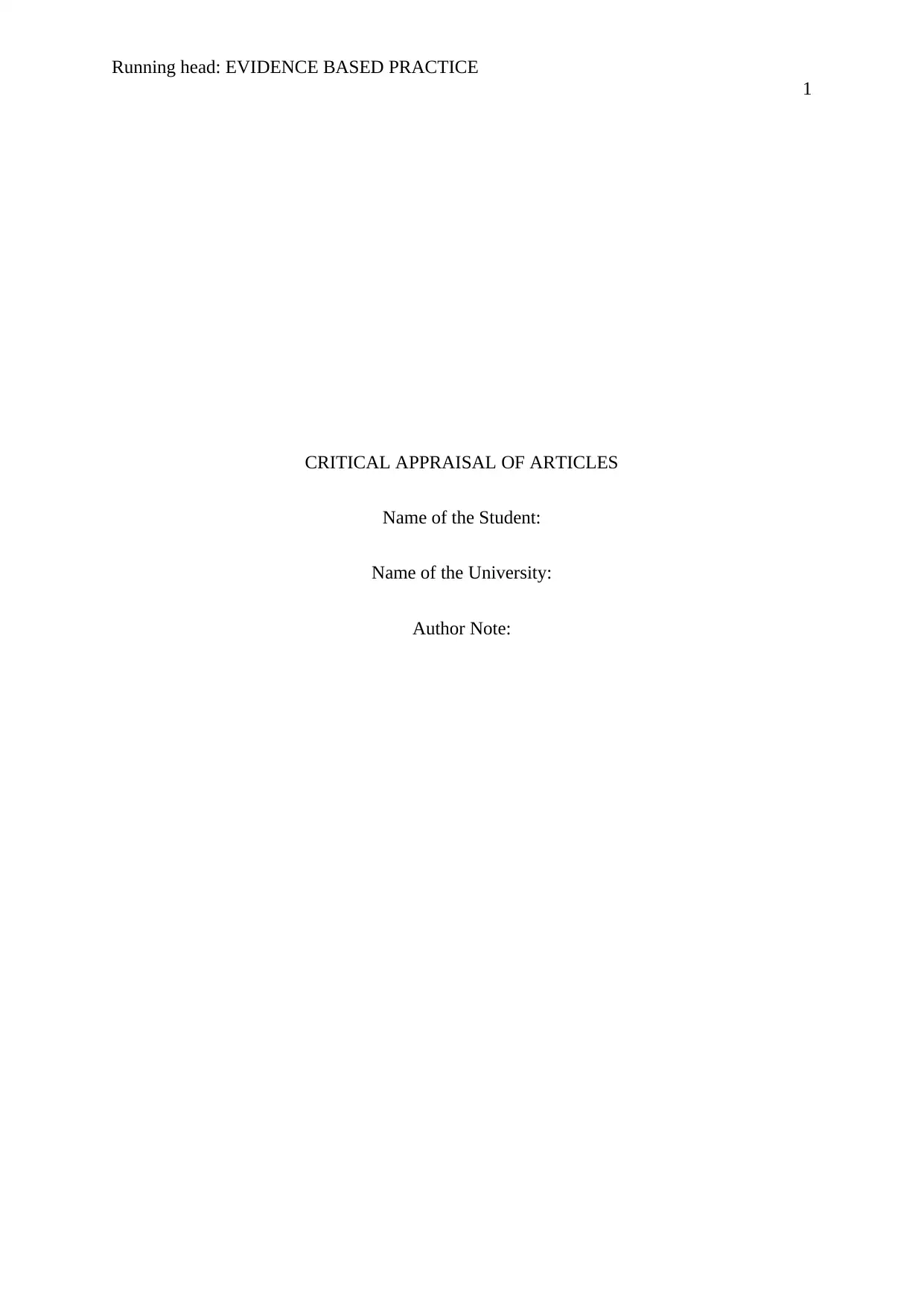
Running head: EVIDENCE BASED PRACTICE
1
CRITICAL APPRAISAL OF ARTICLES
Name of the Student:
Name of the University:
Author Note:
1
CRITICAL APPRAISAL OF ARTICLES
Name of the Student:
Name of the University:
Author Note:
Paraphrase This Document
Need a fresh take? Get an instant paraphrase of this document with our AI Paraphraser
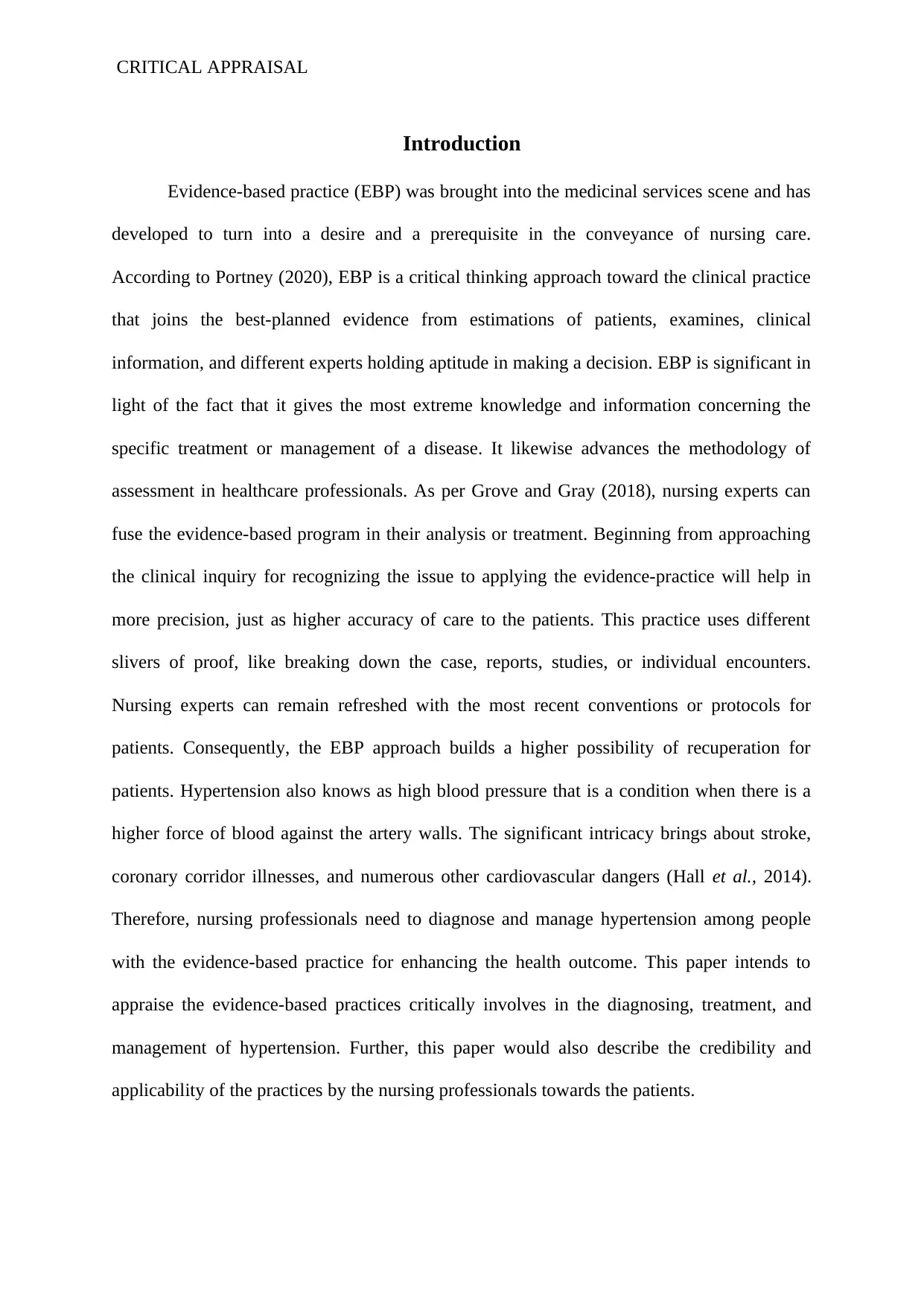
CRITICAL APPRAISAL
Introduction
Evidence-based practice (EBP) was brought into the medicinal services scene and has
developed to turn into a desire and a prerequisite in the conveyance of nursing care.
According to Portney (2020), EBP is a critical thinking approach toward the clinical practice
that joins the best-planned evidence from estimations of patients, examines, clinical
information, and different experts holding aptitude in making a decision. EBP is significant in
light of the fact that it gives the most extreme knowledge and information concerning the
specific treatment or management of a disease. It likewise advances the methodology of
assessment in healthcare professionals. As per Grove and Gray (2018), nursing experts can
fuse the evidence-based program in their analysis or treatment. Beginning from approaching
the clinical inquiry for recognizing the issue to applying the evidence-practice will help in
more precision, just as higher accuracy of care to the patients. This practice uses different
slivers of proof, like breaking down the case, reports, studies, or individual encounters.
Nursing experts can remain refreshed with the most recent conventions or protocols for
patients. Consequently, the EBP approach builds a higher possibility of recuperation for
patients. Hypertension also knows as high blood pressure that is a condition when there is a
higher force of blood against the artery walls. The significant intricacy brings about stroke,
coronary corridor illnesses, and numerous other cardiovascular dangers (Hall et al., 2014).
Therefore, nursing professionals need to diagnose and manage hypertension among people
with the evidence-based practice for enhancing the health outcome. This paper intends to
appraise the evidence-based practices critically involves in the diagnosing, treatment, and
management of hypertension. Further, this paper would also describe the credibility and
applicability of the practices by the nursing professionals towards the patients.
Introduction
Evidence-based practice (EBP) was brought into the medicinal services scene and has
developed to turn into a desire and a prerequisite in the conveyance of nursing care.
According to Portney (2020), EBP is a critical thinking approach toward the clinical practice
that joins the best-planned evidence from estimations of patients, examines, clinical
information, and different experts holding aptitude in making a decision. EBP is significant in
light of the fact that it gives the most extreme knowledge and information concerning the
specific treatment or management of a disease. It likewise advances the methodology of
assessment in healthcare professionals. As per Grove and Gray (2018), nursing experts can
fuse the evidence-based program in their analysis or treatment. Beginning from approaching
the clinical inquiry for recognizing the issue to applying the evidence-practice will help in
more precision, just as higher accuracy of care to the patients. This practice uses different
slivers of proof, like breaking down the case, reports, studies, or individual encounters.
Nursing experts can remain refreshed with the most recent conventions or protocols for
patients. Consequently, the EBP approach builds a higher possibility of recuperation for
patients. Hypertension also knows as high blood pressure that is a condition when there is a
higher force of blood against the artery walls. The significant intricacy brings about stroke,
coronary corridor illnesses, and numerous other cardiovascular dangers (Hall et al., 2014).
Therefore, nursing professionals need to diagnose and manage hypertension among people
with the evidence-based practice for enhancing the health outcome. This paper intends to
appraise the evidence-based practices critically involves in the diagnosing, treatment, and
management of hypertension. Further, this paper would also describe the credibility and
applicability of the practices by the nursing professionals towards the patients.
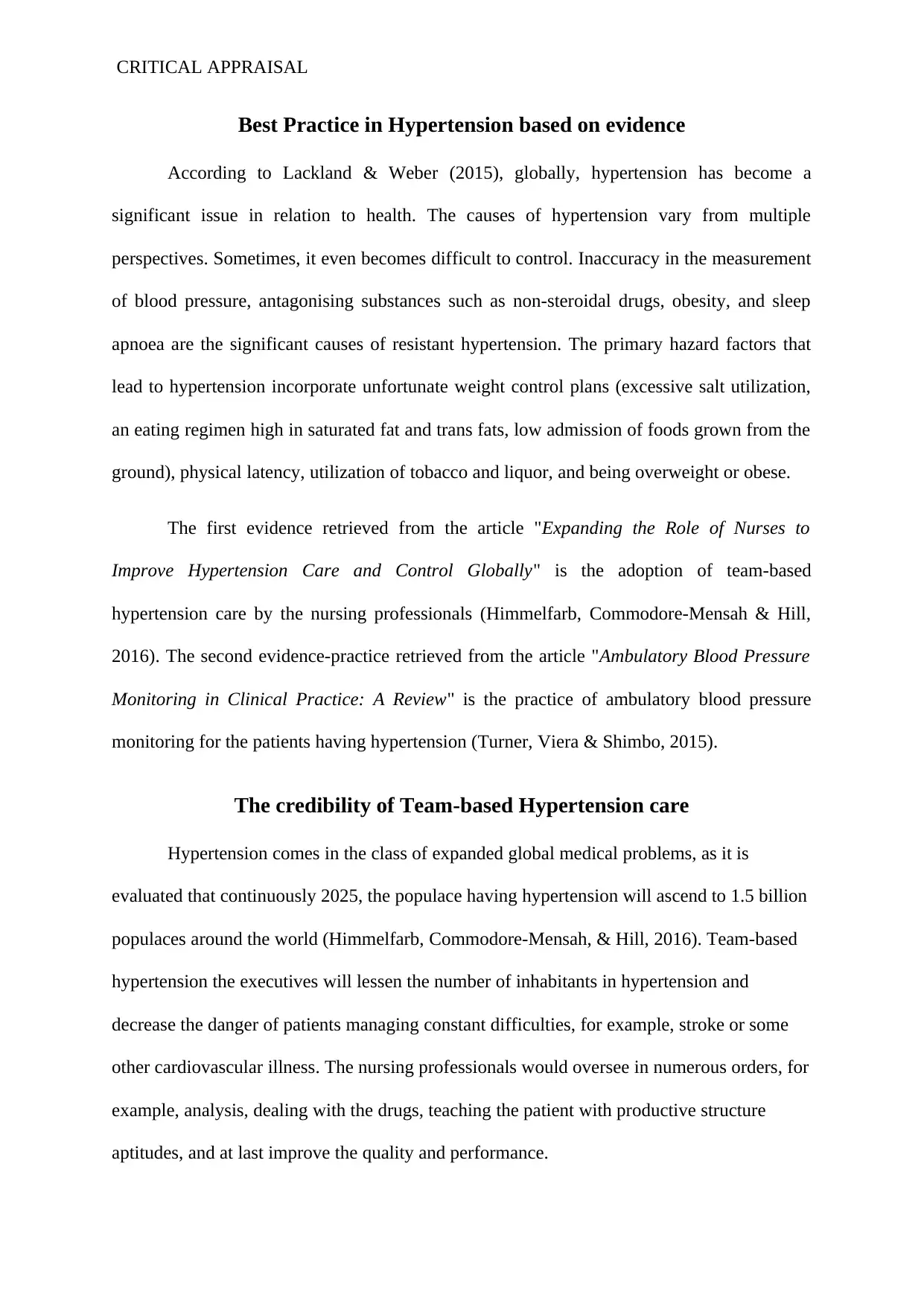
CRITICAL APPRAISAL
Best Practice in Hypertension based on evidence
According to Lackland & Weber (2015), globally, hypertension has become a
significant issue in relation to health. The causes of hypertension vary from multiple
perspectives. Sometimes, it even becomes difficult to control. Inaccuracy in the measurement
of blood pressure, antagonising substances such as non-steroidal drugs, obesity, and sleep
apnoea are the significant causes of resistant hypertension. The primary hazard factors that
lead to hypertension incorporate unfortunate weight control plans (excessive salt utilization,
an eating regimen high in saturated fat and trans fats, low admission of foods grown from the
ground), physical latency, utilization of tobacco and liquor, and being overweight or obese.
The first evidence retrieved from the article "Expanding the Role of Nurses to
Improve Hypertension Care and Control Globally" is the adoption of team-based
hypertension care by the nursing professionals (Himmelfarb, Commodore-Mensah & Hill,
2016). The second evidence-practice retrieved from the article "Ambulatory Blood Pressure
Monitoring in Clinical Practice: A Review" is the practice of ambulatory blood pressure
monitoring for the patients having hypertension (Turner, Viera & Shimbo, 2015).
The credibility of Team-based Hypertension care
Hypertension comes in the class of expanded global medical problems, as it is
evaluated that continuously 2025, the populace having hypertension will ascend to 1.5 billion
populaces around the world (Himmelfarb, Commodore-Mensah, & Hill, 2016). Team-based
hypertension the executives will lessen the number of inhabitants in hypertension and
decrease the danger of patients managing constant difficulties, for example, stroke or some
other cardiovascular illness. The nursing professionals would oversee in numerous orders, for
example, analysis, dealing with the drugs, teaching the patient with productive structure
aptitudes, and at last improve the quality and performance.
Best Practice in Hypertension based on evidence
According to Lackland & Weber (2015), globally, hypertension has become a
significant issue in relation to health. The causes of hypertension vary from multiple
perspectives. Sometimes, it even becomes difficult to control. Inaccuracy in the measurement
of blood pressure, antagonising substances such as non-steroidal drugs, obesity, and sleep
apnoea are the significant causes of resistant hypertension. The primary hazard factors that
lead to hypertension incorporate unfortunate weight control plans (excessive salt utilization,
an eating regimen high in saturated fat and trans fats, low admission of foods grown from the
ground), physical latency, utilization of tobacco and liquor, and being overweight or obese.
The first evidence retrieved from the article "Expanding the Role of Nurses to
Improve Hypertension Care and Control Globally" is the adoption of team-based
hypertension care by the nursing professionals (Himmelfarb, Commodore-Mensah & Hill,
2016). The second evidence-practice retrieved from the article "Ambulatory Blood Pressure
Monitoring in Clinical Practice: A Review" is the practice of ambulatory blood pressure
monitoring for the patients having hypertension (Turner, Viera & Shimbo, 2015).
The credibility of Team-based Hypertension care
Hypertension comes in the class of expanded global medical problems, as it is
evaluated that continuously 2025, the populace having hypertension will ascend to 1.5 billion
populaces around the world (Himmelfarb, Commodore-Mensah, & Hill, 2016). Team-based
hypertension the executives will lessen the number of inhabitants in hypertension and
decrease the danger of patients managing constant difficulties, for example, stroke or some
other cardiovascular illness. The nursing professionals would oversee in numerous orders, for
example, analysis, dealing with the drugs, teaching the patient with productive structure
aptitudes, and at last improve the quality and performance.
⊘ This is a preview!⊘
Do you want full access?
Subscribe today to unlock all pages.

Trusted by 1+ million students worldwide
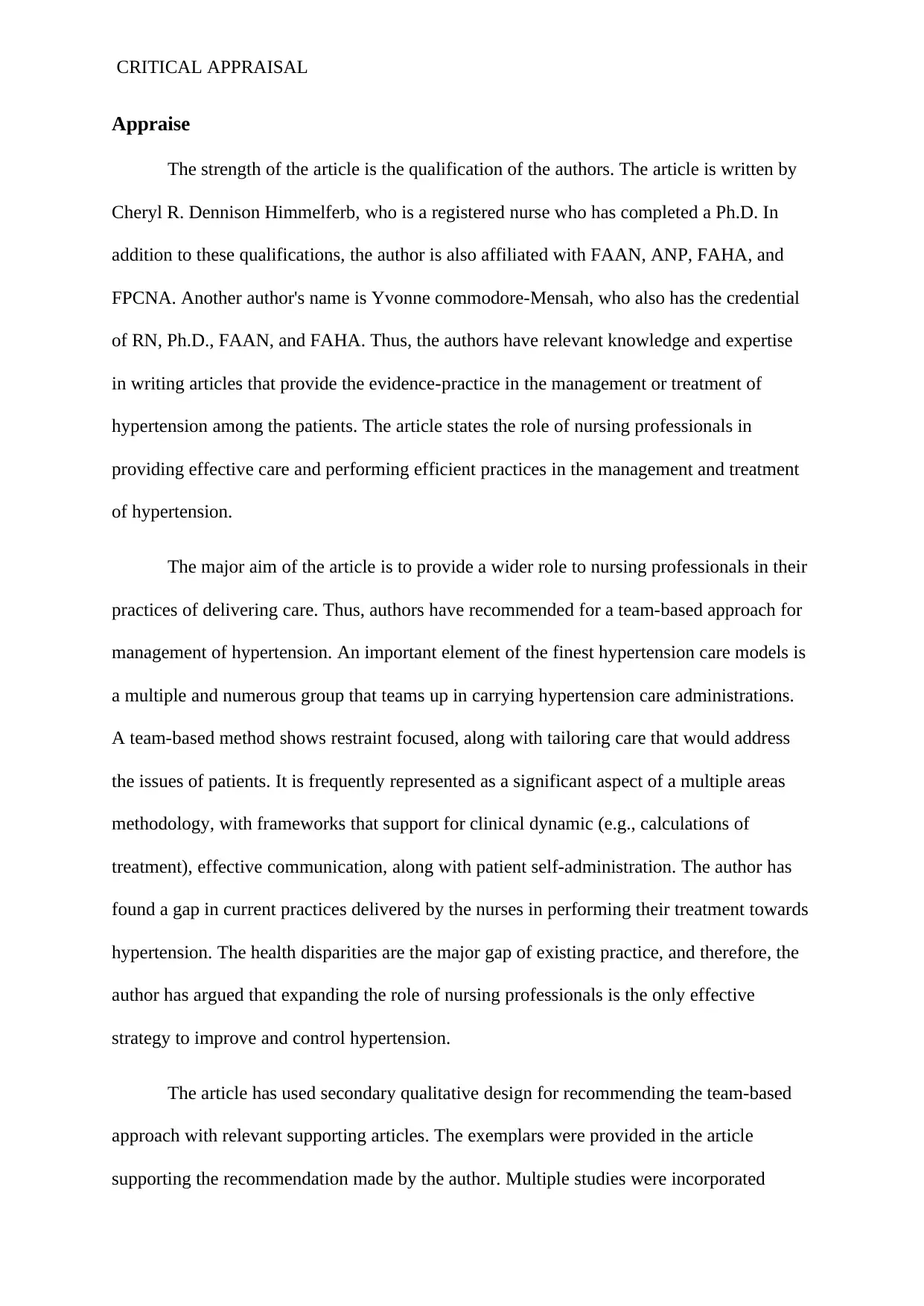
CRITICAL APPRAISAL
Appraise
The strength of the article is the qualification of the authors. The article is written by
Cheryl R. Dennison Himmelferb, who is a registered nurse who has completed a Ph.D. In
addition to these qualifications, the author is also affiliated with FAAN, ANP, FAHA, and
FPCNA. Another author's name is Yvonne commodore-Mensah, who also has the credential
of RN, Ph.D., FAAN, and FAHA. Thus, the authors have relevant knowledge and expertise
in writing articles that provide the evidence-practice in the management or treatment of
hypertension among the patients. The article states the role of nursing professionals in
providing effective care and performing efficient practices in the management and treatment
of hypertension.
The major aim of the article is to provide a wider role to nursing professionals in their
practices of delivering care. Thus, authors have recommended for a team-based approach for
management of hypertension. An important element of the finest hypertension care models is
a multiple and numerous group that teams up in carrying hypertension care administrations.
A team-based method shows restraint focused, along with tailoring care that would address
the issues of patients. It is frequently represented as a significant aspect of a multiple areas
methodology, with frameworks that support for clinical dynamic (e.g., calculations of
treatment), effective communication, along with patient self-administration. The author has
found a gap in current practices delivered by the nurses in performing their treatment towards
hypertension. The health disparities are the major gap of existing practice, and therefore, the
author has argued that expanding the role of nursing professionals is the only effective
strategy to improve and control hypertension.
The article has used secondary qualitative design for recommending the team-based
approach with relevant supporting articles. The exemplars were provided in the article
supporting the recommendation made by the author. Multiple studies were incorporated
Appraise
The strength of the article is the qualification of the authors. The article is written by
Cheryl R. Dennison Himmelferb, who is a registered nurse who has completed a Ph.D. In
addition to these qualifications, the author is also affiliated with FAAN, ANP, FAHA, and
FPCNA. Another author's name is Yvonne commodore-Mensah, who also has the credential
of RN, Ph.D., FAAN, and FAHA. Thus, the authors have relevant knowledge and expertise
in writing articles that provide the evidence-practice in the management or treatment of
hypertension among the patients. The article states the role of nursing professionals in
providing effective care and performing efficient practices in the management and treatment
of hypertension.
The major aim of the article is to provide a wider role to nursing professionals in their
practices of delivering care. Thus, authors have recommended for a team-based approach for
management of hypertension. An important element of the finest hypertension care models is
a multiple and numerous group that teams up in carrying hypertension care administrations.
A team-based method shows restraint focused, along with tailoring care that would address
the issues of patients. It is frequently represented as a significant aspect of a multiple areas
methodology, with frameworks that support for clinical dynamic (e.g., calculations of
treatment), effective communication, along with patient self-administration. The author has
found a gap in current practices delivered by the nurses in performing their treatment towards
hypertension. The health disparities are the major gap of existing practice, and therefore, the
author has argued that expanding the role of nursing professionals is the only effective
strategy to improve and control hypertension.
The article has used secondary qualitative design for recommending the team-based
approach with relevant supporting articles. The exemplars were provided in the article
supporting the recommendation made by the author. Multiple studies were incorporated
Paraphrase This Document
Need a fresh take? Get an instant paraphrase of this document with our AI Paraphraser
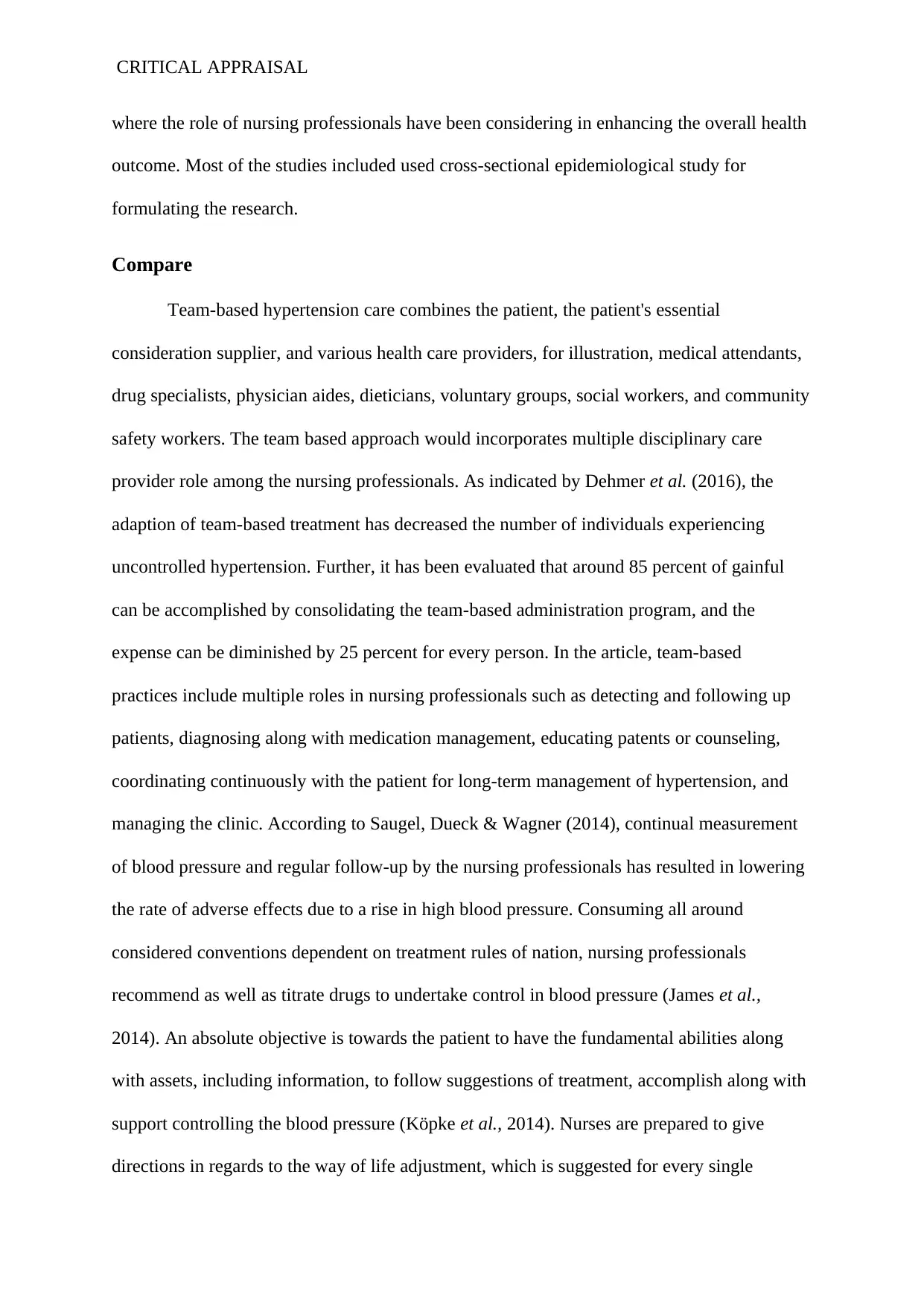
CRITICAL APPRAISAL
where the role of nursing professionals have been considering in enhancing the overall health
outcome. Most of the studies included used cross-sectional epidemiological study for
formulating the research.
Compare
Team-based hypertension care combines the patient, the patient's essential
consideration supplier, and various health care providers, for illustration, medical attendants,
drug specialists, physician aides, dieticians, voluntary groups, social workers, and community
safety workers. The team based approach would incorporates multiple disciplinary care
provider role among the nursing professionals. As indicated by Dehmer et al. (2016), the
adaption of team-based treatment has decreased the number of individuals experiencing
uncontrolled hypertension. Further, it has been evaluated that around 85 percent of gainful
can be accomplished by consolidating the team-based administration program, and the
expense can be diminished by 25 percent for every person. In the article, team-based
practices include multiple roles in nursing professionals such as detecting and following up
patients, diagnosing along with medication management, educating patents or counseling,
coordinating continuously with the patient for long-term management of hypertension, and
managing the clinic. According to Saugel, Dueck & Wagner (2014), continual measurement
of blood pressure and regular follow-up by the nursing professionals has resulted in lowering
the rate of adverse effects due to a rise in high blood pressure. Consuming all around
considered conventions dependent on treatment rules of nation, nursing professionals
recommend as well as titrate drugs to undertake control in blood pressure (James et al.,
2014). An absolute objective is towards the patient to have the fundamental abilities along
with assets, including information, to follow suggestions of treatment, accomplish along with
support controlling the blood pressure (Köpke et al., 2014). Nurses are prepared to give
directions in regards to the way of life adjustment, which is suggested for every single
where the role of nursing professionals have been considering in enhancing the overall health
outcome. Most of the studies included used cross-sectional epidemiological study for
formulating the research.
Compare
Team-based hypertension care combines the patient, the patient's essential
consideration supplier, and various health care providers, for illustration, medical attendants,
drug specialists, physician aides, dieticians, voluntary groups, social workers, and community
safety workers. The team based approach would incorporates multiple disciplinary care
provider role among the nursing professionals. As indicated by Dehmer et al. (2016), the
adaption of team-based treatment has decreased the number of individuals experiencing
uncontrolled hypertension. Further, it has been evaluated that around 85 percent of gainful
can be accomplished by consolidating the team-based administration program, and the
expense can be diminished by 25 percent for every person. In the article, team-based
practices include multiple roles in nursing professionals such as detecting and following up
patients, diagnosing along with medication management, educating patents or counseling,
coordinating continuously with the patient for long-term management of hypertension, and
managing the clinic. According to Saugel, Dueck & Wagner (2014), continual measurement
of blood pressure and regular follow-up by the nursing professionals has resulted in lowering
the rate of adverse effects due to a rise in high blood pressure. Consuming all around
considered conventions dependent on treatment rules of nation, nursing professionals
recommend as well as titrate drugs to undertake control in blood pressure (James et al.,
2014). An absolute objective is towards the patient to have the fundamental abilities along
with assets, including information, to follow suggestions of treatment, accomplish along with
support controlling the blood pressure (Köpke et al., 2014). Nurses are prepared to give
directions in regards to the way of life adjustment, which is suggested for every single
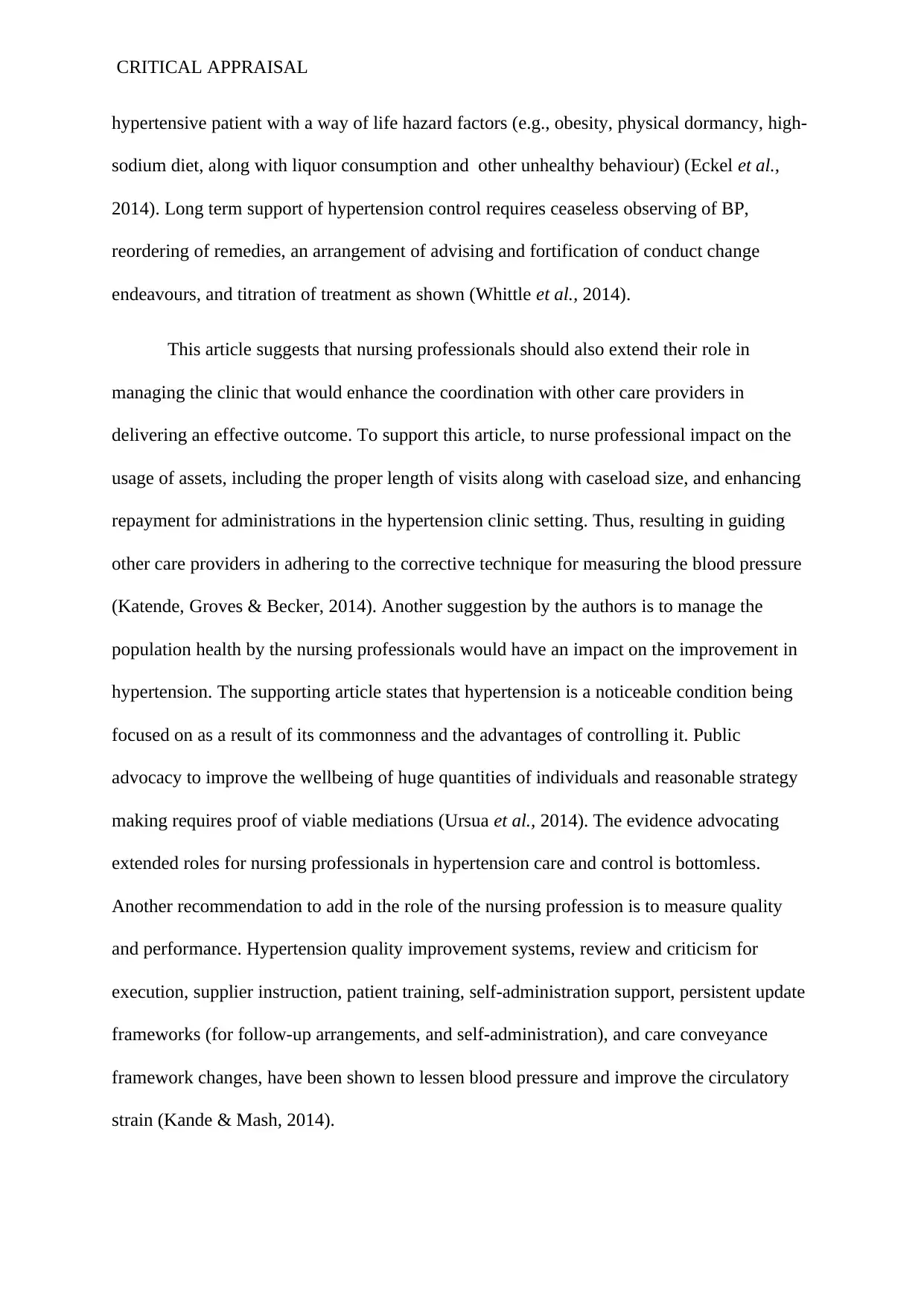
CRITICAL APPRAISAL
hypertensive patient with a way of life hazard factors (e.g., obesity, physical dormancy, high-
sodium diet, along with liquor consumption and other unhealthy behaviour) (Eckel et al.,
2014). Long term support of hypertension control requires ceaseless observing of BP,
reordering of remedies, an arrangement of advising and fortification of conduct change
endeavours, and titration of treatment as shown (Whittle et al., 2014).
This article suggests that nursing professionals should also extend their role in
managing the clinic that would enhance the coordination with other care providers in
delivering an effective outcome. To support this article, to nurse professional impact on the
usage of assets, including the proper length of visits along with caseload size, and enhancing
repayment for administrations in the hypertension clinic setting. Thus, resulting in guiding
other care providers in adhering to the corrective technique for measuring the blood pressure
(Katende, Groves & Becker, 2014). Another suggestion by the authors is to manage the
population health by the nursing professionals would have an impact on the improvement in
hypertension. The supporting article states that hypertension is a noticeable condition being
focused on as a result of its commonness and the advantages of controlling it. Public
advocacy to improve the wellbeing of huge quantities of individuals and reasonable strategy
making requires proof of viable mediations (Ursua et al., 2014). The evidence advocating
extended roles for nursing professionals in hypertension care and control is bottomless.
Another recommendation to add in the role of the nursing profession is to measure quality
and performance. Hypertension quality improvement systems, review and criticism for
execution, supplier instruction, patient training, self-administration support, persistent update
frameworks (for follow-up arrangements, and self-administration), and care conveyance
framework changes, have been shown to lessen blood pressure and improve the circulatory
strain (Kande & Mash, 2014).
hypertensive patient with a way of life hazard factors (e.g., obesity, physical dormancy, high-
sodium diet, along with liquor consumption and other unhealthy behaviour) (Eckel et al.,
2014). Long term support of hypertension control requires ceaseless observing of BP,
reordering of remedies, an arrangement of advising and fortification of conduct change
endeavours, and titration of treatment as shown (Whittle et al., 2014).
This article suggests that nursing professionals should also extend their role in
managing the clinic that would enhance the coordination with other care providers in
delivering an effective outcome. To support this article, to nurse professional impact on the
usage of assets, including the proper length of visits along with caseload size, and enhancing
repayment for administrations in the hypertension clinic setting. Thus, resulting in guiding
other care providers in adhering to the corrective technique for measuring the blood pressure
(Katende, Groves & Becker, 2014). Another suggestion by the authors is to manage the
population health by the nursing professionals would have an impact on the improvement in
hypertension. The supporting article states that hypertension is a noticeable condition being
focused on as a result of its commonness and the advantages of controlling it. Public
advocacy to improve the wellbeing of huge quantities of individuals and reasonable strategy
making requires proof of viable mediations (Ursua et al., 2014). The evidence advocating
extended roles for nursing professionals in hypertension care and control is bottomless.
Another recommendation to add in the role of the nursing profession is to measure quality
and performance. Hypertension quality improvement systems, review and criticism for
execution, supplier instruction, patient training, self-administration support, persistent update
frameworks (for follow-up arrangements, and self-administration), and care conveyance
framework changes, have been shown to lessen blood pressure and improve the circulatory
strain (Kande & Mash, 2014).
⊘ This is a preview!⊘
Do you want full access?
Subscribe today to unlock all pages.

Trusted by 1+ million students worldwide
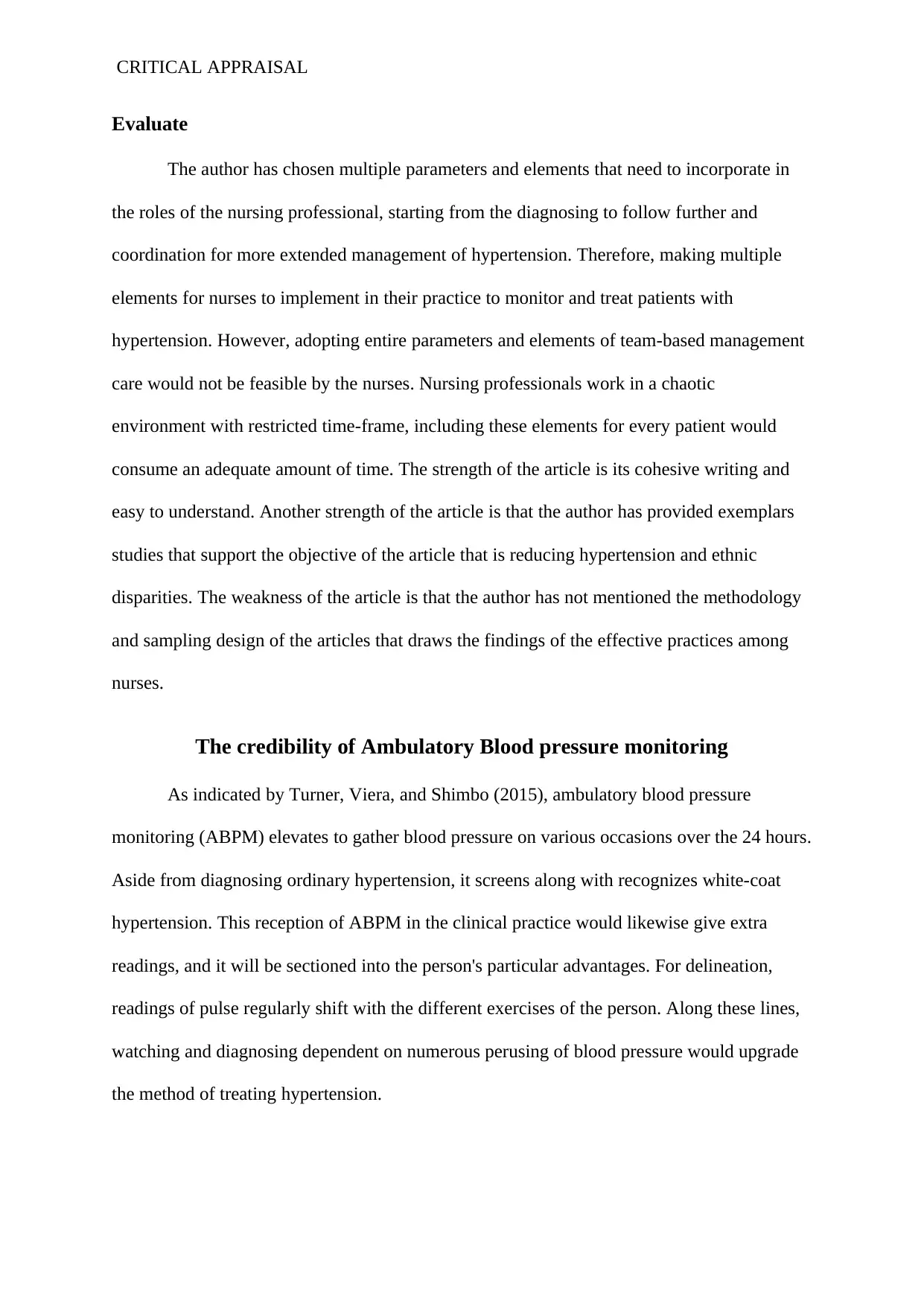
CRITICAL APPRAISAL
Evaluate
The author has chosen multiple parameters and elements that need to incorporate in
the roles of the nursing professional, starting from the diagnosing to follow further and
coordination for more extended management of hypertension. Therefore, making multiple
elements for nurses to implement in their practice to monitor and treat patients with
hypertension. However, adopting entire parameters and elements of team-based management
care would not be feasible by the nurses. Nursing professionals work in a chaotic
environment with restricted time-frame, including these elements for every patient would
consume an adequate amount of time. The strength of the article is its cohesive writing and
easy to understand. Another strength of the article is that the author has provided exemplars
studies that support the objective of the article that is reducing hypertension and ethnic
disparities. The weakness of the article is that the author has not mentioned the methodology
and sampling design of the articles that draws the findings of the effective practices among
nurses.
The credibility of Ambulatory Blood pressure monitoring
As indicated by Turner, Viera, and Shimbo (2015), ambulatory blood pressure
monitoring (ABPM) elevates to gather blood pressure on various occasions over the 24 hours.
Aside from diagnosing ordinary hypertension, it screens along with recognizes white-coat
hypertension. This reception of ABPM in the clinical practice would likewise give extra
readings, and it will be sectioned into the person's particular advantages. For delineation,
readings of pulse regularly shift with the different exercises of the person. Along these lines,
watching and diagnosing dependent on numerous perusing of blood pressure would upgrade
the method of treating hypertension.
Evaluate
The author has chosen multiple parameters and elements that need to incorporate in
the roles of the nursing professional, starting from the diagnosing to follow further and
coordination for more extended management of hypertension. Therefore, making multiple
elements for nurses to implement in their practice to monitor and treat patients with
hypertension. However, adopting entire parameters and elements of team-based management
care would not be feasible by the nurses. Nursing professionals work in a chaotic
environment with restricted time-frame, including these elements for every patient would
consume an adequate amount of time. The strength of the article is its cohesive writing and
easy to understand. Another strength of the article is that the author has provided exemplars
studies that support the objective of the article that is reducing hypertension and ethnic
disparities. The weakness of the article is that the author has not mentioned the methodology
and sampling design of the articles that draws the findings of the effective practices among
nurses.
The credibility of Ambulatory Blood pressure monitoring
As indicated by Turner, Viera, and Shimbo (2015), ambulatory blood pressure
monitoring (ABPM) elevates to gather blood pressure on various occasions over the 24 hours.
Aside from diagnosing ordinary hypertension, it screens along with recognizes white-coat
hypertension. This reception of ABPM in the clinical practice would likewise give extra
readings, and it will be sectioned into the person's particular advantages. For delineation,
readings of pulse regularly shift with the different exercises of the person. Along these lines,
watching and diagnosing dependent on numerous perusing of blood pressure would upgrade
the method of treating hypertension.
Paraphrase This Document
Need a fresh take? Get an instant paraphrase of this document with our AI Paraphraser
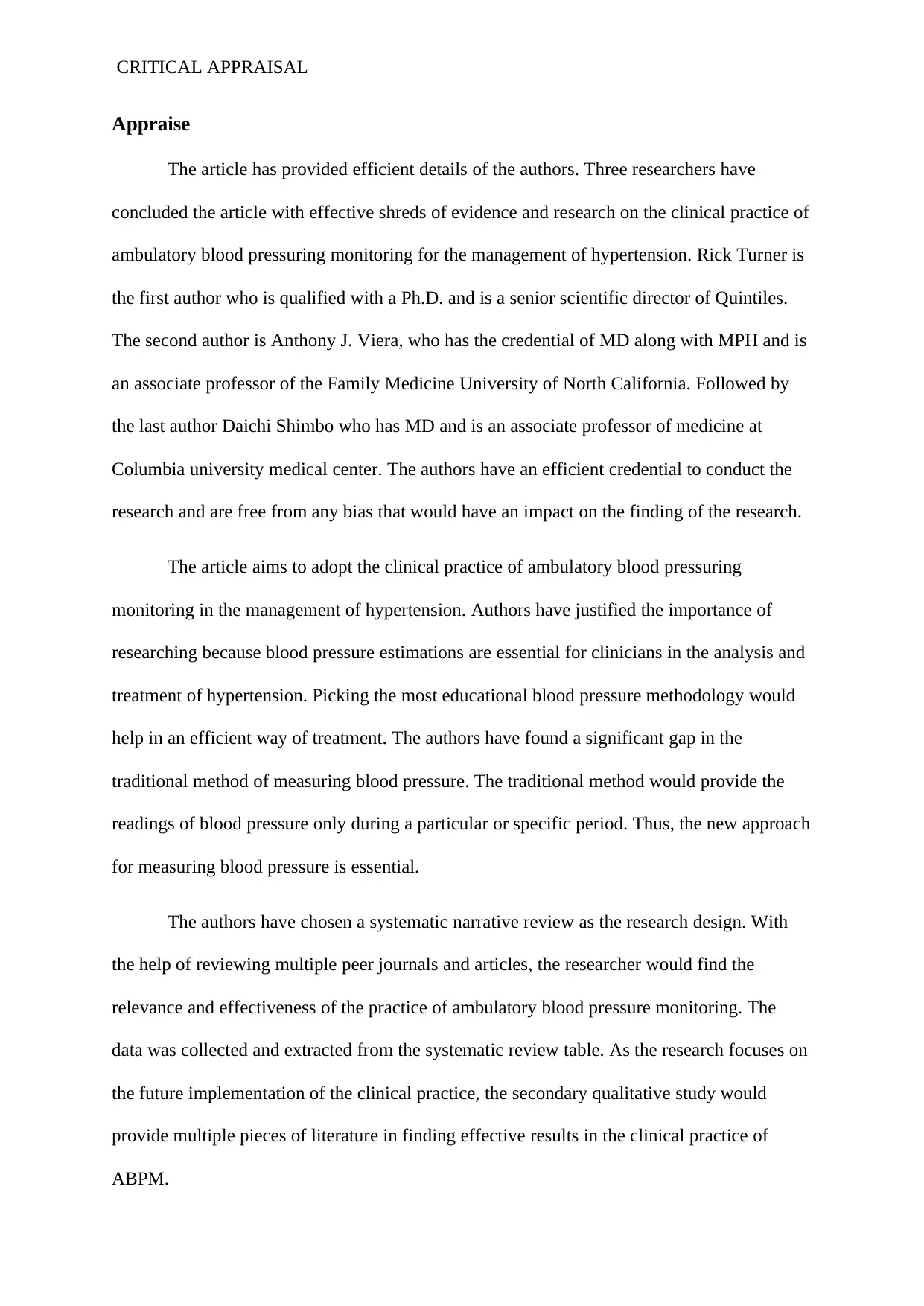
CRITICAL APPRAISAL
Appraise
The article has provided efficient details of the authors. Three researchers have
concluded the article with effective shreds of evidence and research on the clinical practice of
ambulatory blood pressuring monitoring for the management of hypertension. Rick Turner is
the first author who is qualified with a Ph.D. and is a senior scientific director of Quintiles.
The second author is Anthony J. Viera, who has the credential of MD along with MPH and is
an associate professor of the Family Medicine University of North California. Followed by
the last author Daichi Shimbo who has MD and is an associate professor of medicine at
Columbia university medical center. The authors have an efficient credential to conduct the
research and are free from any bias that would have an impact on the finding of the research.
The article aims to adopt the clinical practice of ambulatory blood pressuring
monitoring in the management of hypertension. Authors have justified the importance of
researching because blood pressure estimations are essential for clinicians in the analysis and
treatment of hypertension. Picking the most educational blood pressure methodology would
help in an efficient way of treatment. The authors have found a significant gap in the
traditional method of measuring blood pressure. The traditional method would provide the
readings of blood pressure only during a particular or specific period. Thus, the new approach
for measuring blood pressure is essential.
The authors have chosen a systematic narrative review as the research design. With
the help of reviewing multiple peer journals and articles, the researcher would find the
relevance and effectiveness of the practice of ambulatory blood pressure monitoring. The
data was collected and extracted from the systematic review table. As the research focuses on
the future implementation of the clinical practice, the secondary qualitative study would
provide multiple pieces of literature in finding effective results in the clinical practice of
ABPM.
Appraise
The article has provided efficient details of the authors. Three researchers have
concluded the article with effective shreds of evidence and research on the clinical practice of
ambulatory blood pressuring monitoring for the management of hypertension. Rick Turner is
the first author who is qualified with a Ph.D. and is a senior scientific director of Quintiles.
The second author is Anthony J. Viera, who has the credential of MD along with MPH and is
an associate professor of the Family Medicine University of North California. Followed by
the last author Daichi Shimbo who has MD and is an associate professor of medicine at
Columbia university medical center. The authors have an efficient credential to conduct the
research and are free from any bias that would have an impact on the finding of the research.
The article aims to adopt the clinical practice of ambulatory blood pressuring
monitoring in the management of hypertension. Authors have justified the importance of
researching because blood pressure estimations are essential for clinicians in the analysis and
treatment of hypertension. Picking the most educational blood pressure methodology would
help in an efficient way of treatment. The authors have found a significant gap in the
traditional method of measuring blood pressure. The traditional method would provide the
readings of blood pressure only during a particular or specific period. Thus, the new approach
for measuring blood pressure is essential.
The authors have chosen a systematic narrative review as the research design. With
the help of reviewing multiple peer journals and articles, the researcher would find the
relevance and effectiveness of the practice of ambulatory blood pressure monitoring. The
data was collected and extracted from the systematic review table. As the research focuses on
the future implementation of the clinical practice, the secondary qualitative study would
provide multiple pieces of literature in finding effective results in the clinical practice of
ABPM.
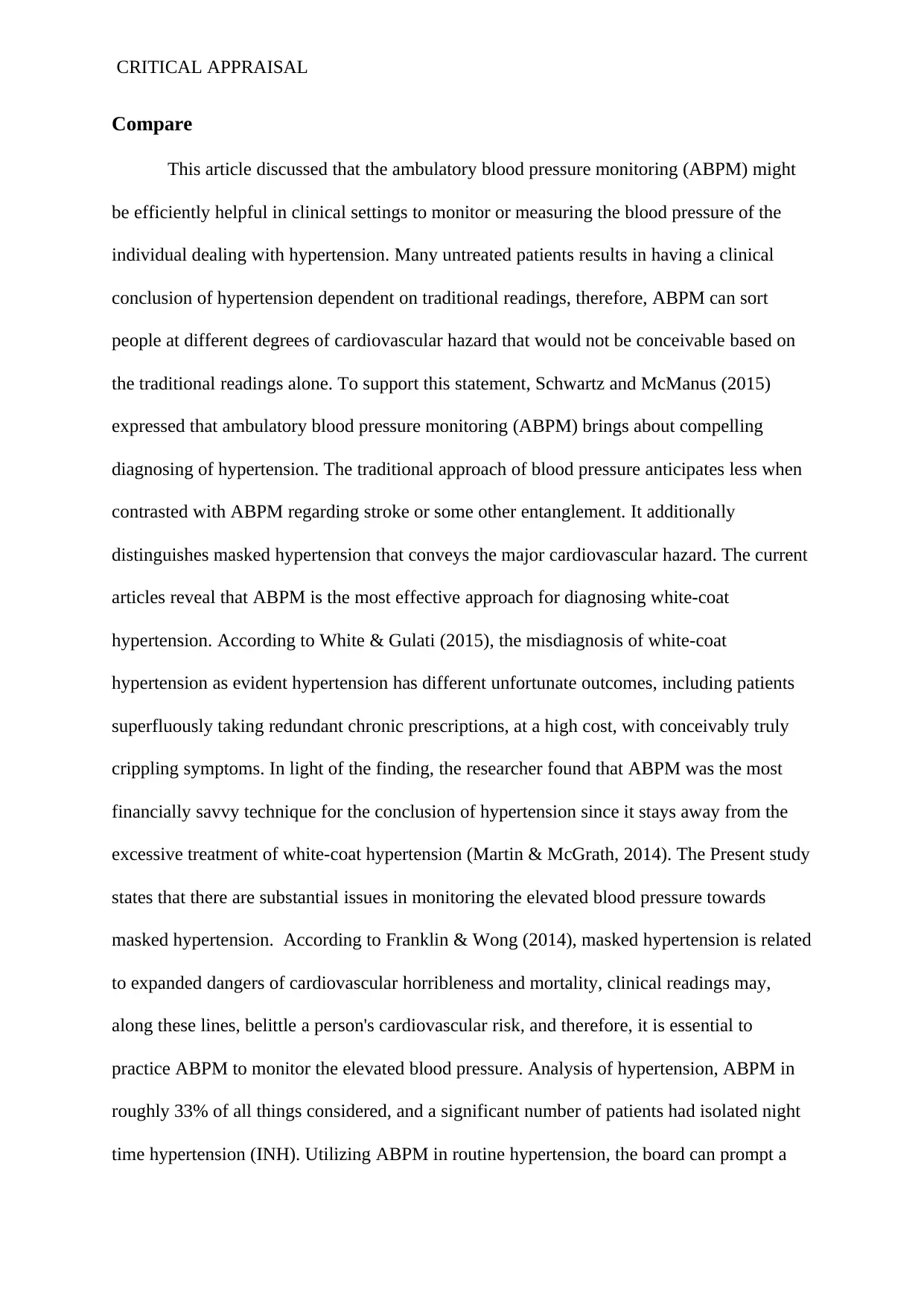
CRITICAL APPRAISAL
Compare
This article discussed that the ambulatory blood pressure monitoring (ABPM) might
be efficiently helpful in clinical settings to monitor or measuring the blood pressure of the
individual dealing with hypertension. Many untreated patients results in having a clinical
conclusion of hypertension dependent on traditional readings, therefore, ABPM can sort
people at different degrees of cardiovascular hazard that would not be conceivable based on
the traditional readings alone. To support this statement, Schwartz and McManus (2015)
expressed that ambulatory blood pressure monitoring (ABPM) brings about compelling
diagnosing of hypertension. The traditional approach of blood pressure anticipates less when
contrasted with ABPM regarding stroke or some other entanglement. It additionally
distinguishes masked hypertension that conveys the major cardiovascular hazard. The current
articles reveal that ABPM is the most effective approach for diagnosing white-coat
hypertension. According to White & Gulati (2015), the misdiagnosis of white-coat
hypertension as evident hypertension has different unfortunate outcomes, including patients
superfluously taking redundant chronic prescriptions, at a high cost, with conceivably truly
crippling symptoms. In light of the finding, the researcher found that ABPM was the most
financially savvy technique for the conclusion of hypertension since it stays away from the
excessive treatment of white-coat hypertension (Martin & McGrath, 2014). The Present study
states that there are substantial issues in monitoring the elevated blood pressure towards
masked hypertension. According to Franklin & Wong (2014), masked hypertension is related
to expanded dangers of cardiovascular horribleness and mortality, clinical readings may,
along these lines, belittle a person's cardiovascular risk, and therefore, it is essential to
practice ABPM to monitor the elevated blood pressure. Analysis of hypertension, ABPM in
roughly 33% of all things considered, and a significant number of patients had isolated night
time hypertension (INH). Utilizing ABPM in routine hypertension, the board can prompt a
Compare
This article discussed that the ambulatory blood pressure monitoring (ABPM) might
be efficiently helpful in clinical settings to monitor or measuring the blood pressure of the
individual dealing with hypertension. Many untreated patients results in having a clinical
conclusion of hypertension dependent on traditional readings, therefore, ABPM can sort
people at different degrees of cardiovascular hazard that would not be conceivable based on
the traditional readings alone. To support this statement, Schwartz and McManus (2015)
expressed that ambulatory blood pressure monitoring (ABPM) brings about compelling
diagnosing of hypertension. The traditional approach of blood pressure anticipates less when
contrasted with ABPM regarding stroke or some other entanglement. It additionally
distinguishes masked hypertension that conveys the major cardiovascular hazard. The current
articles reveal that ABPM is the most effective approach for diagnosing white-coat
hypertension. According to White & Gulati (2015), the misdiagnosis of white-coat
hypertension as evident hypertension has different unfortunate outcomes, including patients
superfluously taking redundant chronic prescriptions, at a high cost, with conceivably truly
crippling symptoms. In light of the finding, the researcher found that ABPM was the most
financially savvy technique for the conclusion of hypertension since it stays away from the
excessive treatment of white-coat hypertension (Martin & McGrath, 2014). The Present study
states that there are substantial issues in monitoring the elevated blood pressure towards
masked hypertension. According to Franklin & Wong (2014), masked hypertension is related
to expanded dangers of cardiovascular horribleness and mortality, clinical readings may,
along these lines, belittle a person's cardiovascular risk, and therefore, it is essential to
practice ABPM to monitor the elevated blood pressure. Analysis of hypertension, ABPM in
roughly 33% of all things considered, and a significant number of patients had isolated night
time hypertension (INH). Utilizing ABPM in routine hypertension, the board can prompt a
⊘ This is a preview!⊘
Do you want full access?
Subscribe today to unlock all pages.

Trusted by 1+ million students worldwide
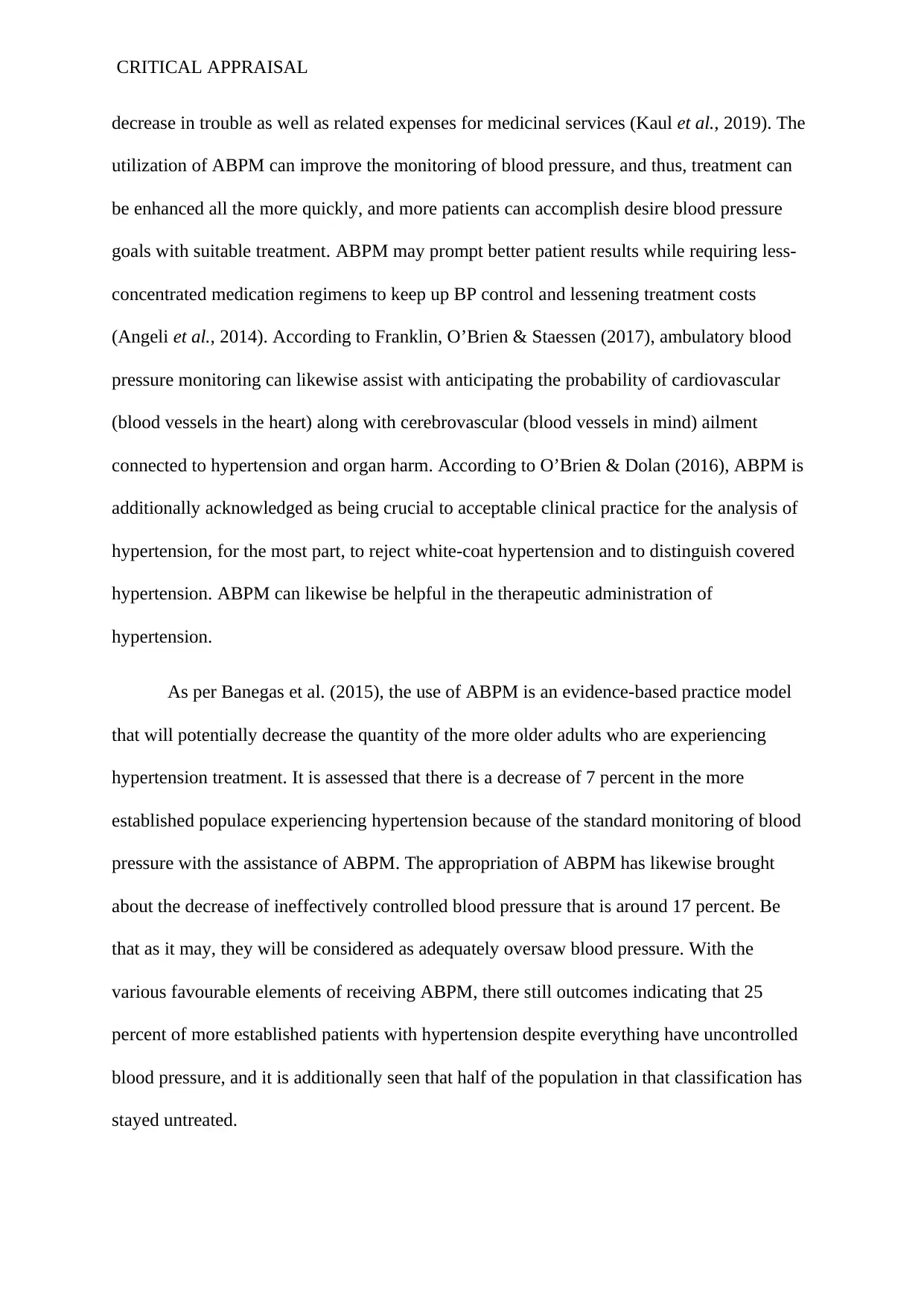
CRITICAL APPRAISAL
decrease in trouble as well as related expenses for medicinal services (Kaul et al., 2019). The
utilization of ABPM can improve the monitoring of blood pressure, and thus, treatment can
be enhanced all the more quickly, and more patients can accomplish desire blood pressure
goals with suitable treatment. ABPM may prompt better patient results while requiring less-
concentrated medication regimens to keep up BP control and lessening treatment costs
(Angeli et al., 2014). According to Franklin, O’Brien & Staessen (2017), ambulatory blood
pressure monitoring can likewise assist with anticipating the probability of cardiovascular
(blood vessels in the heart) along with cerebrovascular (blood vessels in mind) ailment
connected to hypertension and organ harm. According to O’Brien & Dolan (2016), ABPM is
additionally acknowledged as being crucial to acceptable clinical practice for the analysis of
hypertension, for the most part, to reject white-coat hypertension and to distinguish covered
hypertension. ABPM can likewise be helpful in the therapeutic administration of
hypertension.
As per Banegas et al. (2015), the use of ABPM is an evidence-based practice model
that will potentially decrease the quantity of the more older adults who are experiencing
hypertension treatment. It is assessed that there is a decrease of 7 percent in the more
established populace experiencing hypertension because of the standard monitoring of blood
pressure with the assistance of ABPM. The appropriation of ABPM has likewise brought
about the decrease of ineffectively controlled blood pressure that is around 17 percent. Be
that as it may, they will be considered as adequately oversaw blood pressure. With the
various favourable elements of receiving ABPM, there still outcomes indicating that 25
percent of more established patients with hypertension despite everything have uncontrolled
blood pressure, and it is additionally seen that half of the population in that classification has
stayed untreated.
decrease in trouble as well as related expenses for medicinal services (Kaul et al., 2019). The
utilization of ABPM can improve the monitoring of blood pressure, and thus, treatment can
be enhanced all the more quickly, and more patients can accomplish desire blood pressure
goals with suitable treatment. ABPM may prompt better patient results while requiring less-
concentrated medication regimens to keep up BP control and lessening treatment costs
(Angeli et al., 2014). According to Franklin, O’Brien & Staessen (2017), ambulatory blood
pressure monitoring can likewise assist with anticipating the probability of cardiovascular
(blood vessels in the heart) along with cerebrovascular (blood vessels in mind) ailment
connected to hypertension and organ harm. According to O’Brien & Dolan (2016), ABPM is
additionally acknowledged as being crucial to acceptable clinical practice for the analysis of
hypertension, for the most part, to reject white-coat hypertension and to distinguish covered
hypertension. ABPM can likewise be helpful in the therapeutic administration of
hypertension.
As per Banegas et al. (2015), the use of ABPM is an evidence-based practice model
that will potentially decrease the quantity of the more older adults who are experiencing
hypertension treatment. It is assessed that there is a decrease of 7 percent in the more
established populace experiencing hypertension because of the standard monitoring of blood
pressure with the assistance of ABPM. The appropriation of ABPM has likewise brought
about the decrease of ineffectively controlled blood pressure that is around 17 percent. Be
that as it may, they will be considered as adequately oversaw blood pressure. With the
various favourable elements of receiving ABPM, there still outcomes indicating that 25
percent of more established patients with hypertension despite everything have uncontrolled
blood pressure, and it is additionally seen that half of the population in that classification has
stayed untreated.
Paraphrase This Document
Need a fresh take? Get an instant paraphrase of this document with our AI Paraphraser
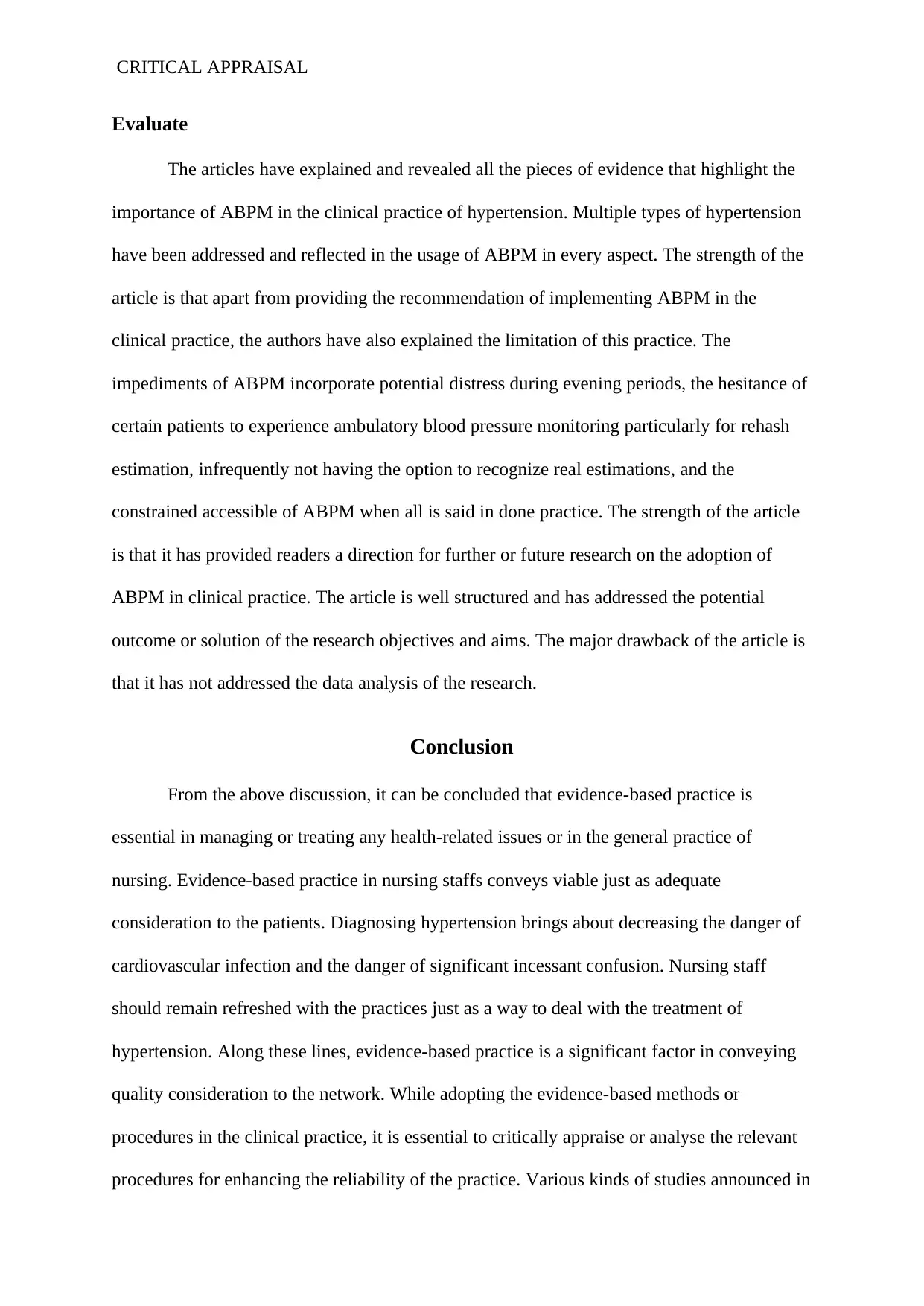
CRITICAL APPRAISAL
Evaluate
The articles have explained and revealed all the pieces of evidence that highlight the
importance of ABPM in the clinical practice of hypertension. Multiple types of hypertension
have been addressed and reflected in the usage of ABPM in every aspect. The strength of the
article is that apart from providing the recommendation of implementing ABPM in the
clinical practice, the authors have also explained the limitation of this practice. The
impediments of ABPM incorporate potential distress during evening periods, the hesitance of
certain patients to experience ambulatory blood pressure monitoring particularly for rehash
estimation, infrequently not having the option to recognize real estimations, and the
constrained accessible of ABPM when all is said in done practice. The strength of the article
is that it has provided readers a direction for further or future research on the adoption of
ABPM in clinical practice. The article is well structured and has addressed the potential
outcome or solution of the research objectives and aims. The major drawback of the article is
that it has not addressed the data analysis of the research.
Conclusion
From the above discussion, it can be concluded that evidence-based practice is
essential in managing or treating any health-related issues or in the general practice of
nursing. Evidence-based practice in nursing staffs conveys viable just as adequate
consideration to the patients. Diagnosing hypertension brings about decreasing the danger of
cardiovascular infection and the danger of significant incessant confusion. Nursing staff
should remain refreshed with the practices just as a way to deal with the treatment of
hypertension. Along these lines, evidence-based practice is a significant factor in conveying
quality consideration to the network. While adopting the evidence-based methods or
procedures in the clinical practice, it is essential to critically appraise or analyse the relevant
procedures for enhancing the reliability of the practice. Various kinds of studies announced in
Evaluate
The articles have explained and revealed all the pieces of evidence that highlight the
importance of ABPM in the clinical practice of hypertension. Multiple types of hypertension
have been addressed and reflected in the usage of ABPM in every aspect. The strength of the
article is that apart from providing the recommendation of implementing ABPM in the
clinical practice, the authors have also explained the limitation of this practice. The
impediments of ABPM incorporate potential distress during evening periods, the hesitance of
certain patients to experience ambulatory blood pressure monitoring particularly for rehash
estimation, infrequently not having the option to recognize real estimations, and the
constrained accessible of ABPM when all is said in done practice. The strength of the article
is that it has provided readers a direction for further or future research on the adoption of
ABPM in clinical practice. The article is well structured and has addressed the potential
outcome or solution of the research objectives and aims. The major drawback of the article is
that it has not addressed the data analysis of the research.
Conclusion
From the above discussion, it can be concluded that evidence-based practice is
essential in managing or treating any health-related issues or in the general practice of
nursing. Evidence-based practice in nursing staffs conveys viable just as adequate
consideration to the patients. Diagnosing hypertension brings about decreasing the danger of
cardiovascular infection and the danger of significant incessant confusion. Nursing staff
should remain refreshed with the practices just as a way to deal with the treatment of
hypertension. Along these lines, evidence-based practice is a significant factor in conveying
quality consideration to the network. While adopting the evidence-based methods or
procedures in the clinical practice, it is essential to critically appraise or analyse the relevant
procedures for enhancing the reliability of the practice. Various kinds of studies announced in
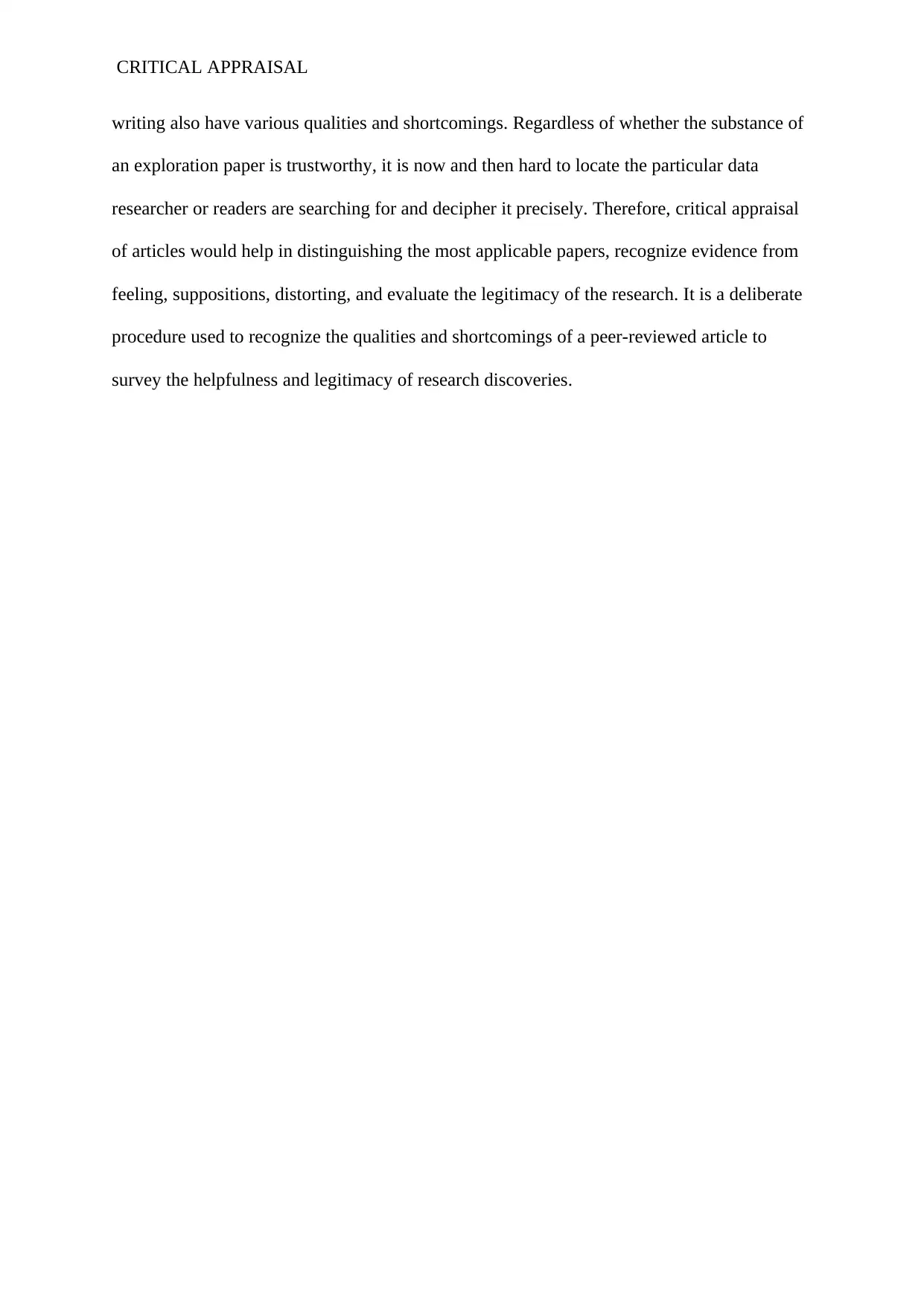
CRITICAL APPRAISAL
writing also have various qualities and shortcomings. Regardless of whether the substance of
an exploration paper is trustworthy, it is now and then hard to locate the particular data
researcher or readers are searching for and decipher it precisely. Therefore, critical appraisal
of articles would help in distinguishing the most applicable papers, recognize evidence from
feeling, suppositions, distorting, and evaluate the legitimacy of the research. It is a deliberate
procedure used to recognize the qualities and shortcomings of a peer-reviewed article to
survey the helpfulness and legitimacy of research discoveries.
writing also have various qualities and shortcomings. Regardless of whether the substance of
an exploration paper is trustworthy, it is now and then hard to locate the particular data
researcher or readers are searching for and decipher it precisely. Therefore, critical appraisal
of articles would help in distinguishing the most applicable papers, recognize evidence from
feeling, suppositions, distorting, and evaluate the legitimacy of the research. It is a deliberate
procedure used to recognize the qualities and shortcomings of a peer-reviewed article to
survey the helpfulness and legitimacy of research discoveries.
⊘ This is a preview!⊘
Do you want full access?
Subscribe today to unlock all pages.

Trusted by 1+ million students worldwide
1 out of 15
Related Documents
Your All-in-One AI-Powered Toolkit for Academic Success.
+13062052269
info@desklib.com
Available 24*7 on WhatsApp / Email
![[object Object]](/_next/static/media/star-bottom.7253800d.svg)
Unlock your academic potential
Copyright © 2020–2025 A2Z Services. All Rights Reserved. Developed and managed by ZUCOL.





